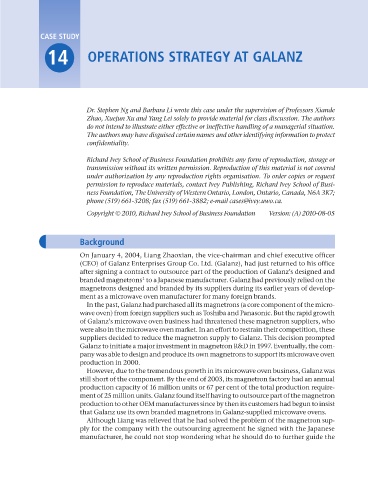Page 476 - Operations Strategy
P. 476
case study 14 • OperatiOns strategy at galanz
Case study
14 OperatiOns strategy at galanz
Dr. Stephen Ng and Barbara Li wrote this case under the supervision of Professors Xiande
Zhao, Xuejun Xu and Yang Lei solely to provide material for class discussion. The authors
do not intend to illustrate either effective or ineffective handling of a managerial situation.
The authors may have disguised certain names and other identifying information to protect
confidentiality.
Richard Ivey School of Business Foundation prohibits any form of reproduction, storage or
transmission without its written permission. Reproduction of this material is not covered
under authorization by any reproduction rights organisation. To order copies or request
permission to reproduce materials, contact Ivey Publishing, Richard Ivey School of Busi-
ness Foundation, The University of Western Ontario, London, Ontario, Canada, N6A 3K7;
phone (519) 661-3208; fax (519) 661-3882; e-mail cases@ivey.uwo.ca.
Copyright © 2010, Richard Ivey School of Business Foundation Version: (A) 2010-08-05
Background
On January 4, 2004, Liang Zhaoxian, the vice-chairman and chief executive officer
(CEO) of Galanz Enterprises Group Co. Ltd. (Galanz), had just returned to his office
after signing a contract to outsource part of the production of Galanz’s designed and
branded magnetrons to a Japanese manufacturer. Galanz had previously relied on the
1
magnetrons designed and branded by its suppliers during its earlier years of develop-
ment as a microwave oven manufacturer for many foreign brands.
In the past, Galanz had purchased all its magnetrons (a core component of the micro-
wave oven) from foreign suppliers such as Toshiba and Panasonic. But the rapid growth
of Galanz’s microwave oven business had threatened these magnetron suppliers, who
were also in the microwave oven market. In an effort to restrain their competition, these
suppliers decided to reduce the magnetron supply to Galanz. This decision prompted
Galanz to initiate a major investment in magnetron R&D in 1997. Eventually, the com-
pany was able to design and produce its own magnetrons to support its microwave oven
production in 2000.
However, due to the tremendous growth in its microwave oven business, Galanz was
still short of the component. By the end of 2003, its magnetron factory had an annual
production capacity of 16 million units or 67 per cent of the total production require-
ment of 25 million units. Galanz found itself having to outsource part of the magnetron
production to other OEM manufacturers since by then its customers had begun to insist
that Galanz use its own branded magnetrons in Galanz-supplied microwave ovens.
Although Liang was relieved that he had solved the problem of the magnetron sup-
ply for the company with the outsourcing agreement he signed with the Japanese
manufacturer, he could not stop wondering what he should do to further guide the
Z14 Operations Strategy 62492.indd 451 02/03/2017 13:59

